The Winter Garden – a berry bounty
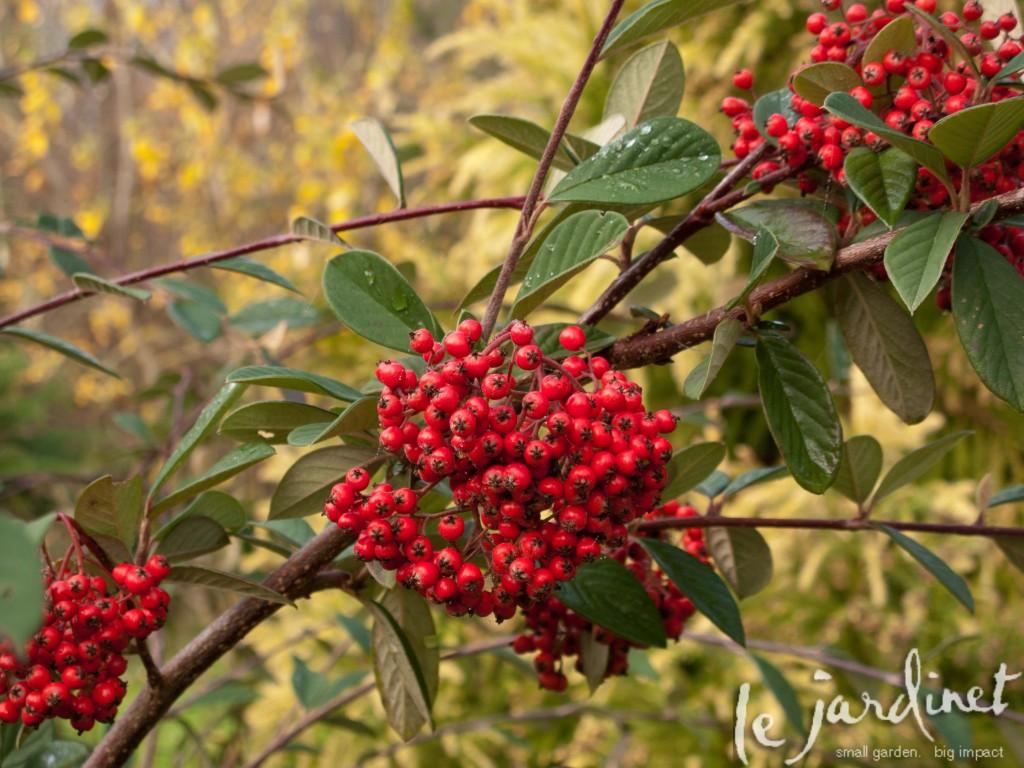
Big fat clusters of berries adorn the branches of Parney cotoneaster - a favorite February treat for robins
A winter garden doesn't just ‘happen’, it takes planning. Most of us visit nurseries earlier in the year when we are seduced into buying ephemeral spring beauties, colorful summer perennials and fall foliage. It takes serious restraint to look beyond those and seek plants that offer great bark, interesting silhouettes, winter flowers and bright berries.
As I strolled around our garden recently on a bright but chilly day I was pleasantly surprised to discover I had in fact put into practice what I encourage others to do! In every part of the garden from the woodland to wilder open spaces there were interesting vignettes with clusters of juicy berries adding seasonal decoration.
Come and walk around the garden with me and I’ll show you a few which are adding jewel like color to our winter garden.
Parney cotoneaster (Cotoneaster lacteus) is a fabulous evergreen shrub for full sun or partial shade. (It will need partial shade in hotter climates). Its long arching branches are dripping with clusters of vivid red fruit- although they would be a little more heavily laden if the deer hadn’t nibbled some of the spring flowers… Come February they will attract flocks of robins to feast on the bounty. The foliage itself is dark green with felted, silvery undersides which catches the light when branches are brushed by a breeze. Give this room to spread to 10’ tall and 8’ wide to enjoy its full beauty although it can be pruned to keep smaller. Zones 6-10b

A PNW native, red chokeberry makes a dazzling fall and winter display with vibrant foliage and red berries
Red chokeberry (Aronia arbutifolia). When we purchased this property in late October 2009 this 6’ tall native shrub was displaying its fiery crimson foliage, almost hiding the red berries. It is planted in partial shade where it is happily spreading by suckers to form a thicket arching over the stream. At this time of year when seen from the house it is framed by an archway of golden foliage from the pear trees. Chokeberry gets its name from the observation that birds avoid this bitter fruit, which suits me fine as I get to enjoy the winter color! Plant it in constantly moist or wet soil in sun or partial shade where it has room to spread, although it is not difficult to remove unwanted canes. It does have somewhat of an unkempt habit so I would recommend this as a background shrub or in a transitional space between the garden and wilder lands beyond – but be sure to site it where you can see it during the winter.
Eichholz cotoneaster (Cotoneaster dammeri ‘Eichholz’). Our stream is fed by three seasonal water sources – a natural aquifer which bubbles up from the stream bed, a neighboring seasonal pond and a pipe which drains water from an area of our garden. This pipe is at the bottom of a 4’ deep French drain so that as much water as possible percolates down and leaches into the surrounding soil – what reaches the pipe is in excess of that saturation point. I needed something to hide the pipe at the head of the stream and chose this evergreen shrub whose stiff woody branches will spread laterally to form an 8’ wide weed suppressing groundcover. At this time of year it is a mass of scarlet berries which add another layer of interest. This likes moisture retentive but well-drained soil in full sun and is hardy in zones 5-8
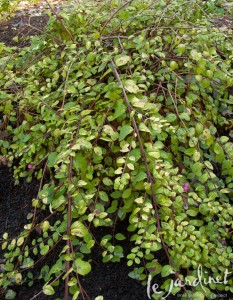
Chartreuse foliage of this snowberry is eye catching from spring to late fall and makes a great contrast to the hot pink berries
I can never resist something new especially if it has fabulous foliage, which is why ‘Blade of Sun’ snowberry (Symphoricarpos chenaultii 'Blade of Sun') leapt into my arms on a summer visit to a nursery! Low spreading branches of chartreuse foliage have been a wonderful addition to our woodland garden and it has been remarkably tolerant of abuse. Although the stream bank where I planted it does not completely dry out, I only watered it two or three times between July and October and it has been fine. It promises to have lots of pink/purple berries in winter and although there are only a scattered few this year I’m optimistic that next year will be more abundant. This is a deciduous shrub yet the foliage is still persisting even after several frosts. It prefers dappled shade where it will grow to 12-18” tall and 2’ wide. Zones 4-9
There are several other berry bearing perennials and shrubs in our garden – ‘Red Beauty’ holly (Ilex x 'Rutzan'), honeysuckle, Pernettya (Pernettya mucronata), barberries (Berberis cv), wintergreen (Gaultheria procumbens), black mondo grass (Ophiopogon planiscapus ‘Nigrescens’), and ‘Coral Beauty ‘ cotoneaster (Cotoneaster dammeri) – enough for both the wildlife and ourselves to enjoy. The latter three are fabulous additions to container gardens also.
Others shrubs you might enjoy;
Beautyberry (Callicarpa sp) – purple
Snowberry (Symphoricarpos sp.) – white or pink
Other hollies (Ilex sp) – red, orange or yellow
Firethorn (Pyracantha sp.) – red, orange or yellow
Viburnum species – red, black or blue
Heavenly bamboo (Nandina domestica)
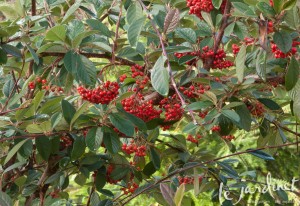
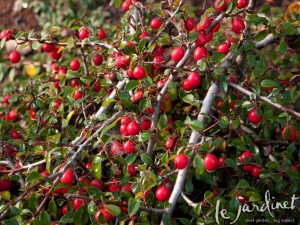
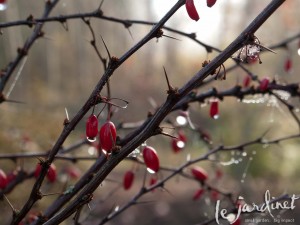
I'd never heard of them but Kristin has choke cherries on her property in Leavenworth (I don't know the variety) and has made jelly from the fruit with her neighbor there this fall. Very pretty color and yummy on toast.
Now I'm confused. You're writing about chokeberries, but they look like Kristin's chokecherries. She also had a commercial jar of chokecherry jelly, produced in Peshastin, near Leavenworth. and this is confusing http://www.pnwplants.wsu.edu/PlantDisplay.aspx?PlantID=24 Fruit is edible AND poisonous? Oh well.
A perfect example of why botanical names are necessary! The red choke berries I have growing in my garden are Aronia arbutifolia; the link you gave is for Prunus virginiana 'Canada Red'. Both bear fruit commonly called choke berries but this latter one is from the flowering plum/cherry family.
I'm not familiar with the Prunus virginiana but it sounds as though toxins need to be heated to be killed to make them safe to eat.
Aronia berries are high in antioxidants and are considered edible but need a lot of sweetening to make them palatable! Birds appear to have discerning taste…..
Here is a link to the Aronia genus and as you'll see there are quite a few different species. I'm not sure which one would be growing in Eastern WA. http://en.wikipedia.org/wiki/Aronia
What was confusing me was the berry/cherry (both choke) but this from your wiki link clarifies a bit: "The chokeberries are often mistakenly called chokecherries, which is the common name for Prunus virginiana. Further adding to the ambiguity, there is a cultivar of Prunus virginiana named 'Melanocarpa',[7][8] easily confused with Aronia melanocarpa. Chokecherries are also high in antioxidant pigment compounds, like anthocyanins, further contributing to confusion. In fact, the two plants are only distantly related within the Rosaceae." At least I'm not the only one confused!
I love the berries! One of the highlights of winter is the lovely berries that stand out against the grays and browns. Today I was noticing our dogwood trees, stripped of leaves but heavy with red berries. Hollies have always been among my favorite. Coralberry, Symphoricarpos orbicultus, is a plant with gorgeous shades of pink to purple berries that is new to my garden. It is a native here, but I only became aware of it last year. I am hoping it will thrive.
Hi Deb, I was thinking of your post last year on holly berries as I wrote this! I hope that eventually our dogwood tree will get tall enough to be out of reach of the deer. the poor thing still looks like a Mohawk so no berries yet.